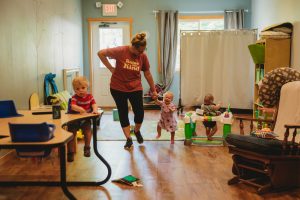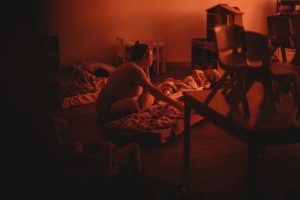Access to child care became increasingly limited across the country during the COVID-19 pandemic. Programs closed and building capacities were restricted, straining caregivers and the economy, which relied heavily on child care to get Americans back to work.
It was a crisis before COVID-19 emerged in early 2020. The Center for American Progress reported that in 2018, more than half of Americans lived in a child care desert – a census tract where resources are so scarce that there are more than 50 children younger than 5 with no child care options, or there are so few options that children outnumber licensed slots 3 to 1.
But in March 2020, when public school systems switched to remote learning, parents who required child care paid high sums for day care centers that relied on workers who were earning minimum wage to carry out an essential service.
A report from the Economic Policy Institute cites a median hourly wage for child care workers of $10.31 an hour.
When COVID-19 cases began to fall this spring and the economy loosened up, those same day care businesses were struggling to recover after months of closures and high turnover of low-wage workers, as well as ongoing pandemic restrictions.
Brooke Skidmore, director of the Growing Tree Child Care Center in New Glarus, Wisconsin, walked through her center with sorrow as she gazed into the classrooms that once held children laughing, playing and learning, but now store excess furniture, toys and supplies.
“I went from having between 12 and 14 teachers down to four teachers,” Skidmore said. “I think I’m now close to 50 children, but we still have wait lists in all ages. But I have multiple rooms that sit empty, and that is, again, lack of teachers.”
Skidmore said that pay has been the primary reason for the shortage of child care teachers.
“I had a teacher who has a degree in early child care, a bachelor’s degree,” Skidmore said. “She had quit to clean houses, even though this was her passion, but she just was going to make more money doing that.”
How COVID-19 impacted centers
Even when centers could reopen, owners had to implement capacity restrictions, which meant that not every parent who needed to send their child back to day care would find an empty spot.
Before COVID-19, child care deserts were predominantly in low- and middle-income communities and rural areas in the United States. However, about two-thirds of child care providers said they couldn’t survive a closure that was longer than one month, according to the Center for American Progress. Once centers could reopen, providers had to incorporate small group sizes in compliance with COVID-19 restrictions.
As a result, many centers have long waitlists.
“I am completely full for several years,” said Leah Zastoupil, owner of Zasty’s Family Child Care in Milton, Wisconsin. “I have a two-year wait list at least, and so I’m getting three, four calls a day and I can’t take any more kids.
“So now there’s such a (child care) desert, is what they call it,” she said.
Zasty’s Family Child Care has been in business for 15 years, and last year was the first time Zastoupil considered quitting, after she and her husband both had COVID-19.
“My husband was off three weeks. I was off two weeks. My two were completely unpaid, plus his third week was unpaid,” Zastoupil said. “So we had three weeks without income in one month. So we used credit cards to survive. I mean, we don’t make a ton of money to have this huge emergency fund.”
Even with the pandemic, Zastoupil said the job is taxing and has never been considered essential to society.
“It’s a very high-stress position to hold,” Zastoupil said. “Having eight children that are depending on you and screaming and have their own personalities. I work a good 70-hour work week every single week.”
Bryan Boroughs, vice president of the Institute for Child Success, said that child care in every state faced challenges.
“Essentially it’s very expensive in terms of staff’s time, especially to provide child care and families who need that service in order to work,” Boroughs said. “A large number of those families don’t have the financial resources to pay for that staff expenses.”
According to Child Care Aware of America, the national average cost of child care is $9,100 to $9,600 per year for all ages.
“In fact, over half the states, it costs more to send your kid to child care than it does to send them to a year of college at a public university,” said Ruth Martin, MomsRising’s senior vice president and chief workplace justice officer.
Alex Bean and Kaylee Walters of New Glarus both had to stay home when the pandemic hit, because the center where they sent their children closed. Bean continued working at his job managing a diagnostics team focusing on COVID-19 testing.
Walters said she juggled her job as a nonprofit administrator with watching her kids. At first, she accessed the COVID-19 emergency relief fund, but once that ended, Walters had to make a decision.
“When everything opened back up, day cares technically opened back up … my boss is kind of like, ‘You can either send your kids to day care or else you can’t do your job,’” Walters said. “I wasn’t quite comfortable yet sending my kids to day care, so I ended up having to leave my job and stay home with my kids.”
Walters’ income from her old job went toward day care.
In February 2021, she opened up the House Cafe and Bakery, which left Bean at home to watch the children while he worked.
“I was managing a lot of the housework myself, taking on this new role and trying to make sure I wasn’t dropping anything at work,” Bean said. “Also dealing with a kid who doesn’t really understand that I’m working even though I’m at home on a computer. … It was stressful and I definitely feel like I wasn’t able to commit myself fully to the things I needed to do at work.”
In early June 2021, Walters and Bean’s two sons went back to full-time day care at the Growing Tree in New Glarus.
Skidmore, the owner, said her list for children younger than 2 is “like a mile-long wait list.”
“Every day, I get parents calling me,” she said. “I had one tearing up because she’s like, ‘How can I work? I can’t work. Nobody will take my baby.’ … It’s a child care crisis.”
Skidmore said she has hired new teachers, but not enough.
Laura Gillaspie, who’s one of those teachers, also attends the University of Wisconsin at Rock County in Janesville. She was looking for a full-time position for the summer that allowed her to spend time with kids.
“It’s such a different job,” Gillaspie said. “I’ve worked in factories like Colony Brands and Duluth Trading Company in the past … or whatever. And this is something, this job is so much more fun and exciting. Everything is new every single day.”
Corrine Hendrickson, who operates Corrine’s Little Explorers in her home in New Glarus, decided to switch her program to be solely outdoors.
“The kids were even napping outside, so unless it was really really hot or it was raining, we were outside,” Hendrickson said. “I had gotten a grant prior to COVID to get boots, rain boots, and rain suits for all of the kids, so that worked out really well.”
Still, she did not accept new enrollments, leaving 14 babies on the wait list.
“It’s really heartbreaking to not feel comfortable enough to help those families out, but at the same time, it’s not worth the risk to expose everybody and shut myself down,” Hendrickson said.
Hendrickson became an advocate for more funding for child care providers, and she wants people to recognize that child care providers are a public good.
“These first five years, 90% of that brain development happens only because of the relationships between a child and a caregiver, parent, whoever they spend their time with,” she said. “So just really making sure people understand that is setting these kids up for failure or success.”
Dana Miller, director of Little Smiling Faces in Upper Marlboro and Mitchellville, Maryland, had to close one of her two locations in March as the pandemic spread. She, too, lost longtime staff members.
“By that time I had already polled my parents, just to kind of see if they were willing to come back, and pretty much 95% were like, ‘No we’re not coming back, because we’re afraid. We don’t know anything about this virus,’” she said.
However, Miller had to continue to pay rent for the location she kept closed.
“It was just a disappointment for me,” Miller said. “It was very disheartening that the community wouldn’t work with me as far as the payments and everything. Like I said, we paid our last rent and we haven’t been in the building since March.”
Carolina Reyes opened Arco Iris Bilingual Children’s Center in Laurel, Maryland, in 2013, but COVID-19 shut it down.
Her teachers had to go on unemployment until Reyes received a loan from the federal Paycheck Protection Program. Once that ran out in summer 2020, the teachers went back on unemployment.
Arco Iris reopened in August 2020, but few of the teachers returned.
“So think about somebody who does not have benefits, who may not have health insurance, and we are living in a pandemic,” Reyes said. “But at this point, I fear that many of them were like, ‘OK, do I risk my life to get this money, or should I continue also with unemployment?’”
In December, Reyes was told by the church she was renting from that she had to become a nonprofit organization if she wanted to continue to hold her center in the building. Instead, Reyes searched for a new building.
“My soul was so sad,” she recalled. “I was like, ‘I need to do something.’ … The email reached out to the parents who used to be here, the parents who were here, the mayor of the city of Laurel, my delegate, the senator of the district and all the other contacts that I knew. … So that way they could be aware of what is really happening to us.”
Reyes hopes that if child care providers speak up, they can bring change.
“When I started Arco Iris, I always started with the idea of changing, if possible, little by little in my center, the opinion or the view about child care with their parents,” Reyes said. “But when you really think about it all, all the things that we do, it’s not just babysitters. That’s the thing that we need to really change.”
The plight of child care providers
The pandemic drew attention to what child care workers already knew – the wages paid to these essential employees are inadequate and unsustainable.
“All of my employees that have kids and families also receive some sort of assistance, even if it is just Medicaid,” said Jennifer Montes, director of Stepping Stones Academy in Lovelock, Nevada. “I don’t have any employees that have a self-sufficient household. It makes me really sad to say that.”
Stepping Stones is one of the only day care centers in Pershing County. Many of the children have parents who are essential workers.
For many of these laborers, the pandemic prompted them to leave the industry for higher wages or, in some cases, petition for wages and benefits they feel they deserve.
Lucrece Lester, a home child care provider in Antioch, California, is a member of the negotiations team for Child Care Providers United, which formed in California in July 2020.
“Respect,” Lester said. “That’s what I hope (for). And that respect then transcends to the compensation that we deserve. … If you do not look at our role in (early childhood education) as vital, necessary, important, if you don’t respect the work that we do, it is not going to (translate) financially.”
Only 15% of child care workers receive health insurance benefits. When the pandemic closed day cares, the workers had limited income to survive on.
“We have to figure out ways of having our needs met,” said Rosa Carreño, a home day care owner in San Jose, California, and member of Child Care Providers United. “It’s not easy. And that’s one of the things we are negotiating with the state, because we need higher rates immediately.”
But, when the customers of day cares are parents who are still recovering from pandemic job losses, raising the rates parents pay is not an option.
In California, as of March 2021, 54% of households with children were still without employment that they had lost in March 2020, according to Kids Count Data Center, a project of the Annie E. Casey Foundation.
“Parents are having issues with their unemployment, and so you’re noticing that the children are coming to day care a little hungrier, or you’re noticing that they’re asking for extras during lunch and snack time,” Lester said.
As a result, she is using her own money to buy extra food for the children. Lester also paid for COVID-19-related cleaning supplies and an electricity bill raised by virtual learners logging onto school classes at her home.
Many of the families who attend day care at Carreño’s home pay the costs with help from a government subsidy. However, even the families paying out of pocket are struggling to make ends meet.
“We worked things out to help them,” Carreño said. “Some of them are making payments, but they are behind on those payments.”
The job can be financially and emotionally taxing. Montes, who has used some of her own money to prepare her day care center for licensing, said she and her staff are exhausted.
“They maintain their classrooms, they change diapers, they – everything, top to bottom every day in their classroom is their responsibility,” Montes said. “It is a lot of work on a minimum-wage salary and no benefits.”
The work of keeping day cares afloat during the pandemic disproportionately fell to women and minorities. Data from the U.S. Bureau of Labor Statistics shows that in 2019, 92% of child care workers in the U.S. were women and 46% were people of color.
“Many (day cares) tried to stay open as much as they could to help serve … the children of front-line workers working in hospitals or who desperately needed the care to be able to sustain their income,” said Melissa Boteach, vice president for income security and child care/early learning at the National Women’s Law Center. “But they themselves often are struggling with poverty, and child care workers are twice as likely to live in poverty as other workers.”
What is ‘universal child care’ and would it help?
Elsa Gomez of Mesa, Arizona, lost her job with a construction company when the pandemic began. Shortly after, she became pregnant with her first child.
Now, a year after she was laid off, the construction site is almost ready to bring her back on, and her daughter is 2 months old. Unemployed, she would qualify for state-subsidized child care. But if she returns to her construction job, she said, her wages would be too high for the subsidy but too low for her to afford care.
“For (the state), I make too much money,” Gomez said. “Honestly, I don’t make enough money to pay so much money for child care and go to work.”
Her only solution now is to ask her mother to quit her job at a dry cleaner to take care of her granddaughter. Gomez said she will pay her mother the amount of money she would have made working at the dry cleaner.
This experience has led Gomez to believe that the federal government should provide child care for all parents.
“I’m hoping that the government starts looking into helping people with kids instead of telling us, ‘Everybody needs to work,’ but we don’t get the resources to help us to go to work, to be able to have our kids be safe,” Gomez said.
The idea of government-subsidized child care, known as universal child care, is a rallying cry for some progressive politicians, but it hasn’t gained much traction.
“I think it is because of our society,” said Matt Rogers, chief strategist with the political consulting firm Politidope. “We’re so individualistic, and we’re kind of taught that from the earliest of ages, that child care is the responsibility of the mother, for the dad to be able to pay for, and for the mom to stay home. And we have not yet had a wholesome public discussion.”
In the wake of the pandemic and its effect on child care, Rogers said the time to talk about universal child care is now. He proposed a wealth tax to help fund a child care program that would be available to every family, just as kindergarten through grade 12 is publicly funded.
Boteach agreed that across the country, every family should have equal access to child care. It’s not valued the same way as education is, she said, because of systemic racism and sexism.
“We would never say for K through 12 public education that we should deal with it with the tax credit or we should deal with it with, you know, that parents should just figure out how to educate their children,” Boteach said. “From 0 to 5, children’s brains are growing at the fastest rate that they do during their lifetimes. And yet we treat this as though it is a luxury instead of a public good. And it’s precisely because of who does the work – women and women of color.”
Janeria Easley, Ph.D., an assistant professor of African American studies at Emory University in Atlanta, a mother and a proponent of universal child care, said that the policy decision would not only help parents, but child care workers.
“There seems to be this problem that it is really difficult to scale up child care in a way that provides really good wages for the child care providers, the day care teachers,” Easley said. “That is a large structural issue. And I don’t think that we’re going to be able to pay people the kind of wages that we need to pay them without subsidizing that in some way.”
During the pandemic, some day care owners had to pay out of pocket for additional expenses created by the pandemic, including covering for parents who couldn’t afford it. Depending on the state, some state subsidies are actually lower than the rate at the day care center.
“I’m not getting that extra money that I would normally get … because I am waiving the parents’ fee and there is higher demand, there’s a higher cost,” Lester said. “And so it’s constantly giving more and being expected more and then having these regulations upon us.”
Lester said her faith and union support helped her withstand the challenges of the pandemic.
“I probably would have closed, because I wouldn’t have had the wherewithal to be able to provide my families the quality service that they deserve,” Lester said.
News21 reporter Jessica Ruiz contributed to this report.
This report is part of Unmasking America, a project produced by the Carnegie-Knight News21 initiative, a national investigative reporting project by top college journalism students and recent graduates from across the country. It is headquartered at the Walter Cronkite School of Journalism and Mass Communication at Arizona State University. For more stories, visit unmaskingamerica.news21.com.
For more stories from Cronkite News, visit cronkitenews.azpbs.org.
^__=








